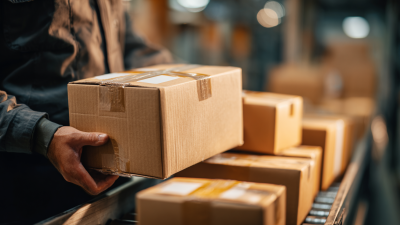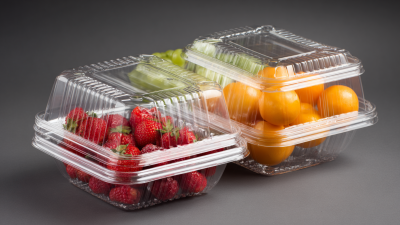The Rising Demand for Plastic Clamshell Packaging in Sustainable Retail Solutions
In recent years, the retail industry has witnessed a significant shift towards sustainable solutions, with a particular emphasis on environmentally-friendly packaging. Among the various options available, plastic clamshell packaging has emerged as a popular choice due to its versatility and durability. This innovative packaging format not only enhances product visibility but also offers convenience for consumers and retailers alike. As businesses increasingly seek to align their practices with sustainability goals, the demand for plastic clamshell packaging continues to rise.
The move towards sustainable retail solutions has led to a surge in interest surrounding the materials and design of packaging. More retailers are recognizing that plastic clamshell packaging—often made from recyclable materials—can play a crucial role in reducing waste while maintaining high standards of product protection. Additionally, this packaging style can easily integrate with recycling initiatives, further solidifying its appeal to eco-conscious consumers.
As the landscape of retail continues to evolve, embracing sustainable solutions like plastic clamshell packaging is not just a trend but a necessity. This approach not only meets consumer expectations for environmental responsibility but also positions businesses at the forefront of innovative retail practices. In this article, we will explore key tips for implementing plastic clamshell packaging in a sustainable manner, outlining its benefits as well as considerations for effective utilization in the retail sector.

Understanding the Benefits of Plastic Clamshell Packaging in Sustainable Retail Practices
The growing trend towards sustainable retail practices has underscored the rising demand for plastic clamshell packaging, which offers a unique combination of benefits for both retailers and consumers. As the packaging sector is identified as the largest source of plastic waste—accounting for about 40% of total plastic demand in Europe—it is essential for retailers to analyze their packaging choices carefully. Clamshells not only provide excellent protection for perishable items, but they are also lightweight, making them a cost-effective option that reduces transportation emissions.
Maintaining sustainability doesn’t mean sacrificing efficiency. For example, transitioning to larger clamshells for products like strawberries has demonstrated that retailers can reduce packaging waste while also meeting consumer demand for bulk purchasing options. According to reports, sustainability-focused retailers are encountering rising costs, making it critical to find a balance between environmentally friendly practices and affordability.
**Tips:**
- Consider incorporating reusable plastic clamshells in your product line to promote recycling efforts among consumers.
- Educate staff and customers about proper waste management practices to encourage recycling of packaging materials.
- Analyze packaging materials regularly to identify opportunities for reducing costs while still meeting sustainability goals.
The Rising Demand for Plastic Clamshell Packaging in Sustainable Retail Solutions
| Dimension | Data |
|---|---|
| Market Growth Rate | 10% CAGR (2023-2030) |
| Recyclability Rate | Approximately 60% |
| Consumer Preference for Eco-Friendly Packaging | 75% of consumers prefer sustainable options |
| Average Cost Savings with Clamshells | 15% cost reduction compared to traditional packaging |
| Packaging Waste Reduction | Reduces packaging waste by up to 30% |
| Product Visibility Enhancement | Increases product visibility by 50% |
| Customization Options Available | 80% of manufacturers offer customization |
Key Trends Driving the Demand for Eco-Friendly Clamshell Solutions
The demand for eco-friendly clamshell packaging has surged in recent years, driven by a growing consumer awareness of sustainability. Retailers are increasingly adopting environmentally responsible practices, leading to a significant shift towards packaging solutions that minimize environmental impact. Consumers now prefer products that utilize sustainable materials and designs, which not only reflect their values but also contribute to a healthier planet. This trend is particularly evident in sectors such as food, cosmetics, and electronics, where the packaging plays a critical role in product presentation and protection.
Another key driver of this demand is the rise of regulatory pressures aimed at reducing plastic waste. Many governments worldwide are implementing stricter regulations on single-use plastics, pushing businesses to innovate and seek alternative packaging solutions. Clamshell packaging made from recycled or biodegradable materials is becoming a preferred choice, as it satisfies both compliance requirements and consumer expectations for sustainability. Companies embracing these eco-friendly clamshell designs can enhance their brand reputation while attracting environmentally conscious customers, ultimately leading to increased market share in the competitive retail landscape.
Innovations in Plastic Clamshell Designs Enhancing Environmental Sustainability
The rising demand for plastic clamshell packaging is closely tied to innovations that enhance environmental sustainability. According to a report by Smithers Pira, the global market for sustainable packaging is projected to reach $500 billion by 2024, with a significant chunk attributed to advancements in clamshell designs. These containers, traditionally made from rigid plastics, are now being developed using recycled materials and bioplastics, which significantly reduce their carbon footprint.
Recent innovations focus on optimizing the design of clamshell packaging to minimize waste and promote recyclability. For instance, companies are investing in thinner, lighter materials that retain strength and functionality, addressing both cost-efficiency and sustainability. A study from the Sustainable Packaging Coalition notes that lighter clamshells can decrease greenhouse gas emissions by up to 29% compared to their heavier counterparts. This not only aligns with global sustainability goals but also meets the evolving consumer demand for eco-friendly packaging solutions. As retailers continue to adopt these innovative clamshell designs, they play a crucial role in driving the shift towards sustainable retail solutions.

Case Studies: Successful Implementations of Clamshell Packaging in Retail
The rising demand for sustainable retail solutions has propelled the adoption of plastic clamshell packaging across various industries. A study by Smithers Pira indicates that the global market for plastic packaging is projected to reach $1 trillion by 2024, with clamshell designs increasingly favored for their ability to provide an effective barrier against contaminants while allowing product visibility. Retailers are finding that clamshell packaging not only enhances product appeal but also aligns with consumer preferences for sustainability.
Case studies from the retail sector have demonstrated successful implementations of clamshell packaging that underscore its potential. For instance, a notable grocery chain reported a 20% increase in sales after switching to clear clamshells for fresh produce, as customers appreciated the eco-friendly alternatives and the product's visibility. Moreover, with the ongoing issues highlighted in India's drug QR code programme, where counterfeit products thrived due to inadequate packaging solutions, the need for robust and secure packaging has never been clearer. This scenario showcases the critical role of effective packaging in safeguarding product integrity while meeting the escalating demands of environmentally-conscious consumers.

Future Perspectives: The Role of Legislation in Shaping Packaging Choices
As the skincare industry continues to expand, the demand for innovative and sustainable packaging solutions becomes increasingly critical. The shift towards eco-conscious consumer behavior is largely driven by heightened awareness surrounding plastic waste and environmental impact. Recent reports indicate that 63% of consumers prioritize sustainability in their purchasing decisions, emphasizing the need for brands to adapt their packaging strategies accordingly. Legislation plays a significant role in this transformation, as regulatory frameworks across Europe and beyond push for increased sustainability in packaging materials and processes. By 2024, new regulations are set to enforce stricter guidelines on waste reduction and circularity, compelling companies to rethink their packaging choices to align with these sustainability goals.
Moreover, consumer attitudes toward packaging materials are evolving, with a growing preference for recyclable and biodegradable options. A survey of global consumers found that 74% express a willingness to pay more for sustainable packaging, highlighting the economic potential of aligning packaging choices with environmental values. As brands navigate this complex landscape, they must synthesize consumer insights with legislative demands, ensuring their packaging not only meets regulatory standards but also resonates with a sustainability-conscious customer base. The dynamic interplay between consumer preferences and regulatory frameworks will undoubtedly shape the future of packaging in the skincare industry and beyond.
Related Posts
-

Addressing Challenges in Clam Packaging for Optimal Product Preservation
-

Essential Checklist for Choosing the Right Plastic Clamshells for Your Products
-

Essential Guide to Choosing the Right Stock Clamshell Packaging for Global Markets
-

Ultimate Guide to Mastering Clam Packaging for Global Buyers
-

Maximize Freshness and Convenience with Innovative Bulk Clamshell Packaging Solutions
-

How to Choose the Right Stock Blister Packaging for Your Products
